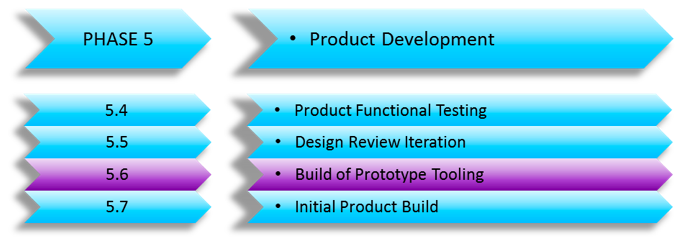 In many cases, manufacturing a new product necessitates the preparation of custom tooling. Therefore phase 5.6 is an important step.
In many cases, manufacturing a new product necessitates the preparation of custom tooling. Therefore phase 5.6 is an important step.
(Don’t forget that you can see the whole series on developing a new product here.)
The output from the design reviews should include a data pack with 3D CAD files and the relevant technical information for each part so that the Chinese supplier can produce tooling that will be able to produce production intent parts.
For example, if we consider a product that has injection molded components, there are a number of different approaches to achieving pre-production parts; the direction you opt for will partly be driven by your budget. If you are looking to launch your product on a limited budget, then full production tooling may be cost-prohibitive, and therefore ‘soft tools’ would be ideal in this case.
These ‘soft tools’ are not actually soft — they are generally made from steel referenced as P20. Tools produced from this steel can normally produce quantities from 10,000 up to 100,000 or more. In some cases, the toolmaker may state a P20 tool is good for 500,000 shots (a shot being a single injection cycle where the tool closes, plastic is injected into the tool, the tool opens and the parts are ejected and the cycle starts again).
Another option is to produce tools from aluminum, but fewer toolmakers provide this service. The most common is the P20 steel option.
Full production tooling, on the other hand, would be manufactured from different grade steel, typically H13 steel. It is able to produce in the region of 1,000,000 shots. Using this harder steel physically takes longer to produce tools, which is why tools produced from P20 or aluminum are often referred to as ‘Rapid Tooling’.
Benefits of Rapid Tooling/Soft Tooling
- The rapid tooling process produces tools in a much shorter time frame than that of conventional tooling (in the region of one quarter the time to first tool trial).
- Getting parts quicker allows testing to start earlier and consequently, any issues found that require changes can be introduced earlier in the development process.
- The cost of producing these tools is lower than the conventional tools.
- These tools can be used for limited production runs (generally up to 100,000 shots), which means the product can be introduced to the market and start to generate revenue which could be used for replacement by fully hardened production tooling.
- Getting product to market faster with tooling being produced quicker than conventional tooling allows for a product to be introduced to the market that much quicker.
Design for Manufacture (DFM) Analysis
During the pre-production tooling stage, DFM analysis should be carried out. This process ensures the product and each of the parts has been designed in such a way that they can be manufactured with ease.
Some DFM general guidelines are:
- Standardize parts wherever possible
- Reduce the overall number of components (can two parts be designed as one, for example)
- Reduce the number and types of parts
- Design in mistake-proofing features
- Design parts for best handling and orientation
- Design for ease of assembly
- Design for assembly direction (during assembly the parts should be added from the top without having to keep turning the assembly all the time)
- Minimise flexible parts and too many connections
Some DFM guidelines specific to molded parts:
- Ensure correct draft angle has been applied so that part ejects from tool cleanly
- Design the tool taking into consideration the correct shrinkage rate for the polymer specified
- Slides should be designed and optimized for minimum wear and maximum accuracy
- Parting lines should be positioned to allow for best separation of cavities which allow for clean part ejection
- Ejection points should be positioned so that they eject the part with even pressure and without damaging the part
- Wall thickness optimization is very important when designing a part (incorrect wall thickness can result in sink marks and poor part integrity)
- Mold structure is a review of the gate type and position, venting, cooling, and lifter designs
- Pressure optimization of the injection process
- The temperature of the tool and the injection process, to ensure parts are molded correctly
- Tolerance analysis of the part to ensure in mass production the process can reliably and repeatably produce parts within specification
Go to part 12: Initial Product Build
Want to learn more about the new product introduction process for hardware startups?
Whether you’re some way along the process, or just starting out, Sofeast’s guide covers everything hardware startups need to know for making a new product in China and successfully bringing it to market.
Hit the button below to read the guide:


